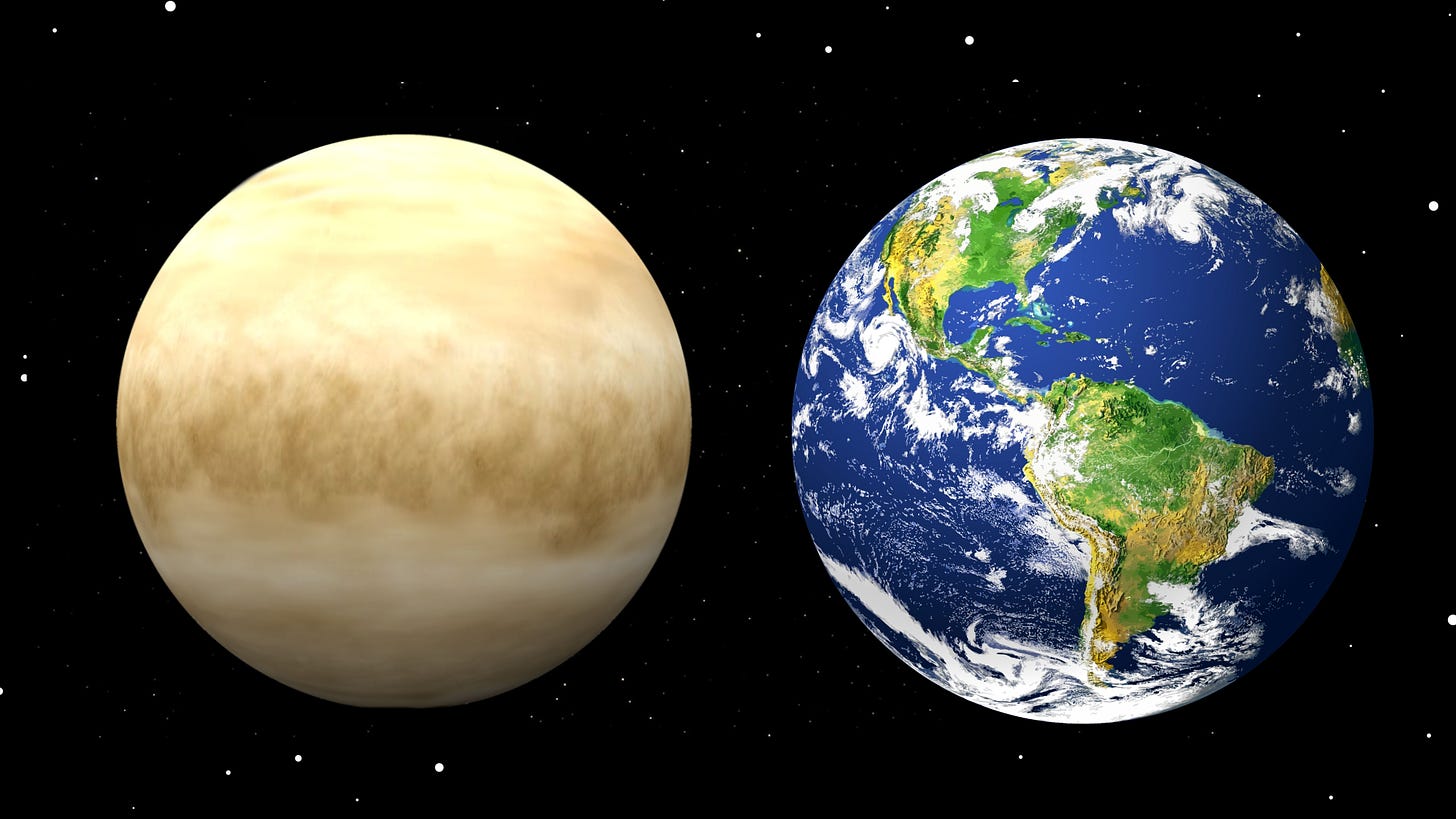Life: The True Architect of Planetary Habitability?
Though Venus is the hottest planet in our solar system, it appears cooler than Earth when viewed from space.
#3 Your Daily-ish Knowledge Dose
Hi everyone!
I've always found joy in learning or thinking about at least one new thing each day.
It's a small but happy habit that keeps my curiosity alive and my mind engaged. That's why I started a new section to the blog: "Your Daily-ish Knowledge Dose."
In this space, I'll be sharing ideas, and tidbits that spark thought and inspire deeper understanding.
I hope these daily doses of knowledge will enrich your day just as much as they do mine.
And if there's something you're curious about or a topic you'd love to dive into, feel free to share your thoughts—let’s explore together!
P.S. If this post sparked your curiosity, hit the ❤️ button—it helps more curious minds discover this journey!
Life: The True Architect of Planetary Habitability?
Imagine an alien astronomer peering through their advanced telescopes, observing our solar system.
Their focus lands on Earth—a planet that, despite being farther from the Sun than Venus, paradoxically appears hotter from space.
What could explain this enigma?
The answer lies not just in our atmosphere or our proximity to the Sun, but in the very essence of life itself.
Did You Know? Venus's Deceptive Appearance
Though Venus is the hottest planet in our solar system, it appears cooler than Earth when viewed from space. Briefly why:
High Albedo: Venus's thick sulfuric acid clouds reflect most sunlight, giving it a bright, cool look from afar.
Dense Atmosphere: Composed mainly of carbon dioxide, Venus's atmosphere is 90 times denser than Earth's, trapping immense heat at the surface.
Runaway Greenhouse Effect: The trapped heat creates scorching surface temperatures, but the reflective clouds keep its outer appearance deceivingly cool.
So, while Venus might seem cooler from a distance, its surface is actually far hotter, showcasing the complexities of planetary atmospheres!
Earth's Atmospheric Alchemy: A Product of Life
Earth stands unique in our solar system, not merely because it harbors life, but because life has dramatically reshaped its environment.
The curious fact that Earth appears hotter than Venus from space arises from the way our planet radiates thermal energy.
Earth's atmosphere, rich in life-driven gases like oxygen (21%) and methane (1.8 ppm), plays a crucial role in this process.
Key Atmospheric Components:
Nitrogen (N₂): 78%
Oxygen (O₂): 21%
Argon (Ar): 0.93%
Carbon Dioxide (CO₂): 0.04%
Trace gases: Including methane, water vapor, and ozone
This atmospheric composition ensures that while the upper atmosphere is hot enough to radiate the Sun's energy back into space, the surface remains cool and stable, perfect for sustaining life.
The average surface temperature of Earth is a comfortable 15°C (59°F), compared to Venus's scorching 475°C (887°F).
Redefining the "Habitable Zone"
The concept of a "habitable zone," traditionally defined as the region around a star where conditions might be right for liquid water, may need reevaluation.
Earth's environment isn't just a product of its distance from the Sun; it's a dynamic system, heavily influenced by the presence of life.
Comparative Planetary Data:
Without the complex interplay of life processes, Earth could very well resemble its inhospitable neighbors, either frozen over like Mars or scorched like Venus.
Life: The Cosmic Sculptor
What if life, wherever it exists, is the true architect of a planet's habitability?
This idea challenges the long-held belief that planets within a certain distance from their star naturally possess the conditions needed for life.
Instead, it suggests that life itself is a driving force in creating and maintaining those conditions.
Earth's Biogeochemical Cycles:
Carbon Cycle: Annually processes about 200 gigatons of carbon
Nitrogen Cycle: Fixes approximately 413 million tons of nitrogen per year
Water Cycle: Moves about 577,000 km³ of water annually
These cycles, driven by life, work together to keep Earth's climate stable over geological timescales, allowing life to thrive.
The Paradox of Existence
Our existence on Earth is a paradox. We are both nurtured by our Sun and threatened by it. The Sun provides the energy that fuels life on our planet, yet in about 5 billion years, it will transform into a red giant, engulfing Earth in a final, fiery embrace.
Solar Evolution Timeline:
Present: Main sequence star, 4.6 billion years old
1 billion years: 10% increase in luminosity, potential threat to Earth's biosphere
5-7 billion years: Red giant phase begins
7.5 billion years: Earth potentially engulfed by expanding Sun
Implications for Exoplanet Research
As we search for life beyond our planet, perhaps we should consider that life itself might be the key to making any world habitable. The search for extraterrestrial life might not just be about finding a planet within the "right" distance from its star but finding a planet where life has had the opportunity to take hold and shape its environment.
Exoplanet Detection Methods:
Transit Method
Radial Velocity Method
Direct Imaging
Gravitational Microlensing
Future missions like the James Webb Space Telescope (JWST) and the proposed LUVOIR (Large UV/Optical/IR Surveyor) will be capable of detecting biosignatures in exoplanet atmospheres, potentially revealing worlds where life has already begun to shape its environment.
Food for Thought
As we ponder the profound relationship between life and habitability, a few intriguing questions arise:
Extremophile Seeding: What do you think about the idea of introducing extremophile life forms—organisms that thrive in extreme conditions—to barren planets like Mars or Europa?
Could these resilient forms of life kickstart the process of making these worlds more habitable?
Martian Terraforming: Can we terraform Mars by extreme measures, such as releasing trapped CO₂ from its poles to thicken its atmosphere?
Elon Musk famously suggested using nuclear weapons for this purpose, but what are the ethical and practical implications of such drastic measures?
Earth as a Template: If life is indeed the key to planetary habitability, should our search for extraterrestrial life focus more on finding Earth-like biosignatures rather than just Earth-like physical conditions?
The “Road to Earth 2.0” is long and fraught with challenges, but it's a journey that could deepen our understanding of life, habitability, and our place in the cosmic tapestry.
Thanks :)
Enjoying my writing? Wanna join me on the road and support my work?
And if these ideas got you thinking, consider sharing or recommending the journey to others.
Wanna read more?
Stay tuned for the next blog post coming!
Until then, take care!







I did not know that about Venus and I'm a bit if an astronomy nerd 🤓